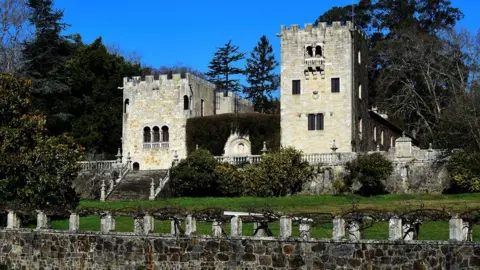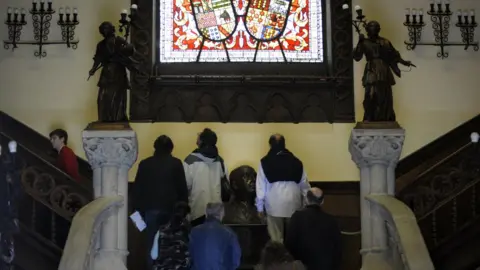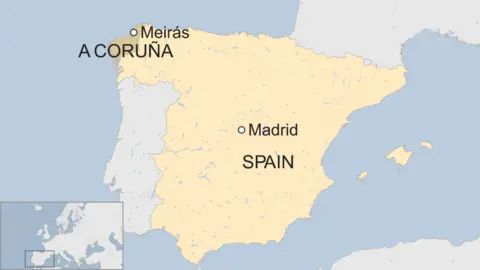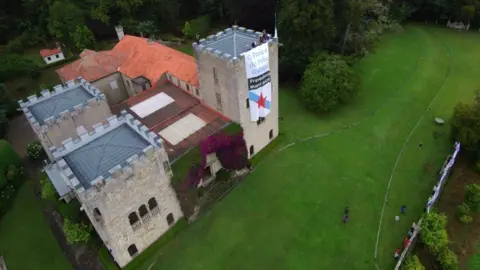The battle to strip Franco family of dictator's summer palace
 Getty Images
Getty ImagesThe provincial authority of A Coruña, in north-western Spain, has launched a legal battle to expropriate a mansion used by 20th Century dictator Francisco Franco as a summer residence, arguing that the former Generalissimo's heirs have no right to enjoy the ownership of "plunder".
The discovery last month that Franco's grandchildren had put the sturdy Pazo de Meirás palace up for sale was the last straw for politicians who want to see the fortified building and grounds open to the public.
"It's a scandal that this property continues to be controlled by the dictator's family," says Néstor Rego, one of around 25 activists from the Galicia region who invaded the property for a few hours in protest last year.
Now the leaders of the provincial authority of A Coruña, to which the village of Meirás belongs, have announced a legal and political offensive aimed at stripping the Franco family of the dictator's mock-medieval pile.
"There are legal ways to recover the Pazo de Meirás for the public realm," said Goretti Sanmartín, deputy president of the A Coruña authority, as she presented a report drawn up by historical and legal experts on the mansion's status.
She appealed for "a consensus between all political forces and all levels of government".
The report probes the circumstances of the donation of the property to the then leader of rebellious Nationalist forces during Spain's 1936-39 civil war, and presents what it says is evidence that the dictator fraudulently took legal ownership of the palace via a "simulated" purchase contract after the conflict ended.
Donation under duress?
According to the Franco regime's official account, the donation of the Pazo de Meirás for the leader's use was a sacrifice born of the Galician people's loyalty to the fascist general, who was born nearby in the port town of Ferrol.
Local historians, however, say the leaders of A Coruña's council and business community essentially obliged local people to hand over a portion of their income and wealth to purchase the property, expand its grounds and furnish the palace to the standards of the country's military leader.
 Getty Images
Getty Images"There was nothing voluntary about the donations," says Carlos Babío, co-author of a historical study of the building entitled Meirás, Un Pazo, Un Caudillo, Un Espolio (Meirás, a palace, a warlord, a plunder).
"Money was taken from workers' wages, and we're talking about practically the entire population of A Coruña in 1938."
According to Xabier Ferreira, a law lecturer from the University of Santiago de Compostela who helped to draw up the report for A Coruña's provincial authority, Franco realised that the donation had been made to the "head of state" and not him personally.

Francisco Franco (1892-1975)
 Getty Images
Getty Images- Born in Galicia to a military family, became the youngest general in Spain in the 1920s
- Following the election of the leftist Popular Front in 1936, Franco and other generals staged a coup which sparked the three-year Spanish Civil War
- With support from Nazi Germany and Mussolini's Italy, Franco won the war in 1939 and established a dictatorship, proclaiming himself head of state - "El Caudillo"
- Franco retained power until his death in 1975, after which Spain made a transition to democracy

In 1941 the property was signed over to Spain's dictator and his wife, Carmen Polo, for 85,000 pesetas, although no money was exchanged before the notary public who oversaw the transaction.
"The Pazo de Meirás should have become [a] national heritage [building at the time], and that is what leads us to the conclusion that the deal in 1941 was aimed at avoiding this," said Mr Ferreira.
'Spoils of war'
Mr Babío, along with his fellow historian, Manuel Pérez, found out that some 60 small landholders around Meirás, including his own grandmother, saw their lands expropriated as the dictator's estate grew in size, while stone was brought in from other "looted" buildings to embellish the palace.
The Pazo's grounds were expanded from 5.7 acres to the "extraordinary" 16-acre property currently being advertised by real estate company Mikeli under a price tag of €8m (£7m).
 Courtesy of Carlos Babío
Courtesy of Carlos Babío"The Pazo of 1975 [the year Franco died] has nothing to do with the Pazo of 1938," says Mr Babío.
"It has hosted 30 cabinet meetings, other public events and the extensions and improvements were all paid for by the state - yet it's impossible to put a figure on how much was spent.
"It starts out as being part of the spoils of war, then becomes a summer residence for 36 years."
Summers at the palace included visits by Spain's future king, Juan Carlos, and his young family, including current monarch Felipe VI, in the late 1960s and early 1970s.

Franco's daughter Carmen Franco Polo continued to use the Pazo as a summer retreat, but her death in December appears to have triggered the decision to sell the residence by her seven children.
The BBC asked the Franco family to comment for this article, but the request was declined.
Franco Foundation
Controversy has dogged the Franco family's use of the Pazo since Galicia's regional government decided in 2008 to declare the property "heritage of cultural interest", a move that meant its doors must be opened to the public at least four days a month.
The family's compliance with this rule was fitful and some local politicians such as Mr Rego, a member of the Galician Nationalist Bloc (BNG), were outraged when it emerged that the Francisco Franco Foundation had taken over the organisation of these public visits, using them as an opportunity to defend Franco's political legacy as a nation builder.
 Courtesy of Néstor Rego
Courtesy of Néstor Rego"It's unthinkable that there could exist in Germany a Hitler foundation or an Italian Benito Mussolini foundation glorifying the lives of these dictators," says Mr Rego, adding that the heirs' decision to sell up is just "one more affront".
"I think it will be very difficult for them to sell the Pazo. Any potential owner has to know that it is in dispute, and the fact that they are trying suggests to me that they realise how awkward an inheritance it is."
